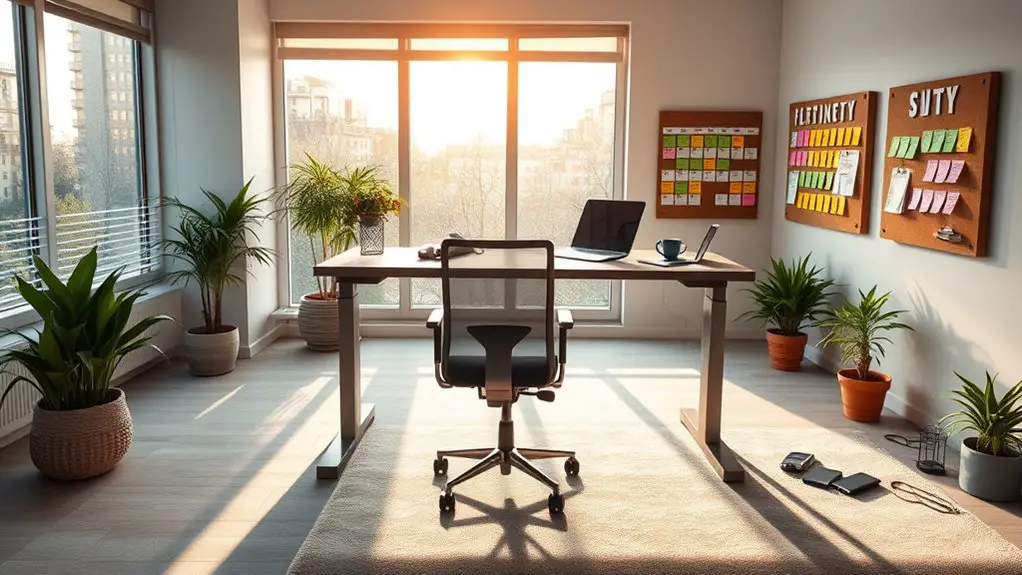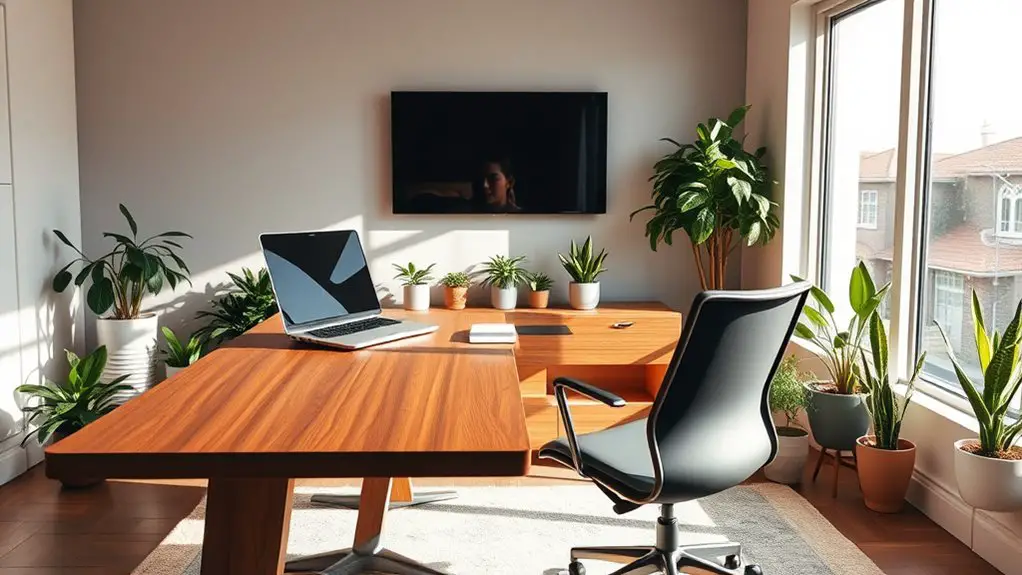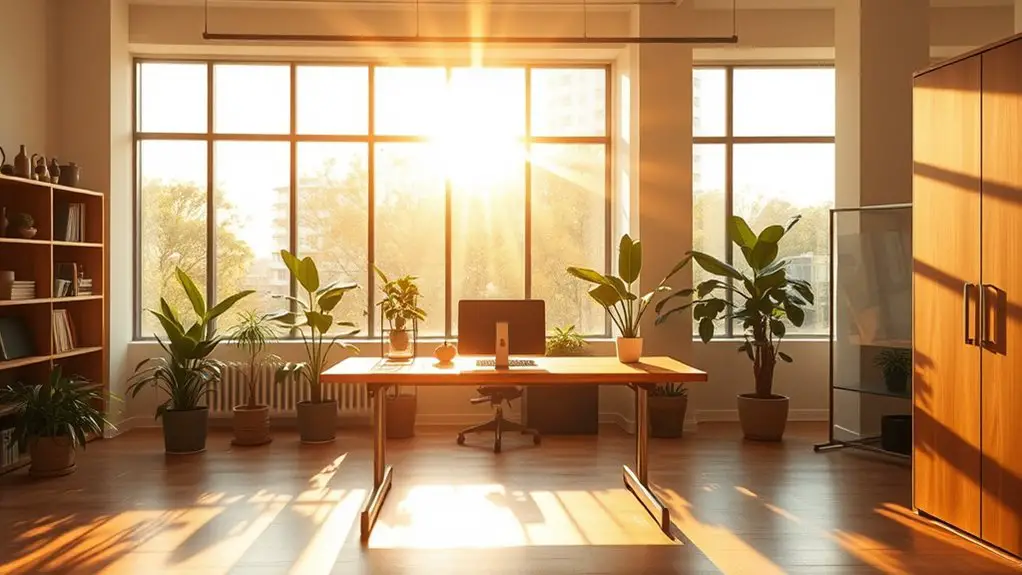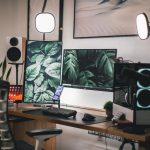To design a workspace that adapts to your changing needs, start by evaluating your work habits and identifying distractions. Choose flexible furniture solutions that can be reconfigured easily. Incorporate smart technology for convenience and efficiency. Create designated zones for focused tasks, collaboration, and relaxation. Maximize natural light and airflow to enhance comfort. Finally, maintain a clutter-free environment to boost productivity. Discover even more ways to create an adaptable workspace that fits you perfectly.
Table of Contents
Key Takeaways
- Choose multi-functional and modular furniture that can easily be rearranged for various tasks and team sizes.
- Designate specific zones for focused work, collaboration, and relaxation to enhance productivity and adaptability.
- Integrate smart technology for seamless connectivity and automation, allowing adjustments based on user preferences and needs.
- Maximize natural light and airflow to create a comfortable and energizing workspace that promotes well-being and creativity.
- Implement effective cable management and storage solutions to maintain a clutter-free environment that supports an adaptable workspace.
Assessing Your Current Work Habits

How effective are your current work habits? Take a moment to reflect on how you approach your daily tasks.
Are you easily distracted, or do you stay focused? Assess your productivity levels throughout the day. Do you find yourself working overtime to meet deadlines, or do you manage your time efficiently?
Evaluate your focus and productivity throughout the day. Are you managing your time effectively or constantly racing against deadlines?
Consider the tools you use and how they support or hinder your workflow. Are you leveraging technology to streamline processes, or are you stuck in outdated methods?
Think about your workspace: Is it organized, or does clutter distract you? By evaluating these factors, you can identify areas for improvement.
This assessment helps you understand what changes can enhance your efficiency and create a workspace that truly supports your evolving needs.
Choosing Flexible Furniture Solutions
When choosing flexible furniture solutions, think about how multi-functional pieces can save space and adapt to your needs.
Consider modular designs that allow you to reconfigure your workspace easily as your tasks change. This approach not only enhances functionality but also keeps your environment dynamic and engaging.
Multi-functional Furniture Options
In today's ever-evolving work environment, choosing multi-functional furniture can transform your space into a dynamic and efficient workspace. These versatile pieces not only save space but also adapt to your changing needs. Consider options like a desk that doubles as a meeting table or a sofa bed for occasional guests.
Here's a quick comparison of popular multi-functional furniture options:
| Furniture Type | Functionality | Ideal Use Case |
|---|---|---|
| Sofa Bed | Seating and sleeping | Guest rooms |
| Folding Desk | Workspace and storage | Small areas |
| Storage Ottoman | Seating and hidden storage | Living room |
| Convertible Table | Dining and workspace | Dining areas |
| Nesting Tables | Space-saving tables | Flexible arrangements |
Invest in pieces that work harder for you!
Modular Design Considerations
As you explore modular design for your workspace, keep in mind that flexibility is key to adapting to various tasks and team dynamics.
Choose furniture that can easily be rearranged or reconfigured. Look for items like desks with adjustable heights, movable partitions, and stackable chairs to create a dynamic environment.
Think about integrating solutions that promote collaboration, such as modular seating arrangements or tables that can expand for group work.
Consider materials that are durable yet lightweight, making it easy to switch up your setup.
Finally, prioritize storage options that blend seamlessly into your design, ensuring everything has a place without cluttering your space.
Incorporating Smart Technology

Incorporating smart technology into your workspace can greatly enhance both productivity and comfort.
Start by integrating smart lighting that adjusts based on natural light levels, helping reduce eye strain and boost focus. Consider adding voice-activated assistants to streamline tasks, manage schedules, or control devices hands-free.
Integrate smart lighting and voice-activated assistants to enhance focus and streamline daily tasks in your workspace.
Smart thermostats can maintain an ideal temperature, ensuring you stay comfortable throughout the day. Use high-quality noise-canceling speakers or smart sound systems to create an optimal auditory environment.
Finally, invest in ergonomic smart furniture that adapts to your posture, promoting better health.
Creating Designated Zones for Different Tasks
Smart technology can set the stage for a more efficient workspace, but having designated zones for different tasks takes organization to the next level.
Start by identifying the key activities you perform, like focused work, meetings, or creative brainstorming. Set up distinct areas for each task, ensuring that your environment supports your goals.
For example, create a quiet corner for concentration, equipped with noise-canceling headphones and comfortable seating. Design an open area for collaboration, with a whiteboard and group seating.
Don't forget a space for relaxation and breaks to recharge your mind. By organizing your workspace into designated zones, you'll enhance productivity and maintain a clear separation between tasks, allowing you to switch gears effortlessly throughout the day.
Maximizing Natural Light and Airflow

How can you transform your workspace into a more inviting and energizing environment? Start by maximizing natural light. Position your desk near windows to let in sunlight, which boosts your mood and productivity. If possible, use sheer curtains to soften harsh light while still allowing brightness in.
Next, enhance airflow by keeping windows open when weather permits. Fresh air invigorates your space and keeps you alert. Consider adding plants, as they not only improve air quality but also create a calming atmosphere.
Utilize fans or air purifiers to maintain ideal airflow, ensuring your workspace feels fresh.
Personalizing Your Space for Inspiration
While creating a workspace that inspires you, consider adding personal touches that reflect your unique style and interests. This not only boosts your creativity but also makes the space feel welcoming.
Here are three ideas to personalize your workspace:
- Inspiring Art: Hang artwork or photos that motivate you. Choose pieces that resonate with your goals or spark joy.
- Meaningful Decor: Incorporate items that tell your story, like souvenirs from travels or gifts from loved ones. These pieces can provide comfort and inspiration.
- Personalized Stationery: Use custom notebooks, pens, or desk organizers that match your aesthetics. This small detail can make a big difference in how you feel while working.
Embrace these elements to create a workspace that truly reflects who you are!
Planning for Future Growth and Changes
As you plan your workspace, it's essential to contemplate how it can adapt to future growth and changes.
Flexible furniture solutions and modular design principles will help you create a dynamic environment that evolves with your needs.
Plus, integrating the right technology can enhance functionality and keep your workspace relevant for years to come.
Flexible Furniture Solutions
When planning for future growth and changes, incorporating flexible furniture solutions can greatly enhance your workspace's adaptability.
By choosing the right pieces, you can easily accommodate a variety of work styles and team sizes. Here are three flexible furniture solutions to evaluate:
- Adjustable Desks: These allow employees to switch between sitting and standing, promoting comfort and productivity.
- Modular Seating: With movable components, you can reconfigure seating arrangements for collaboration or solo work, catering to different needs.
- Mobile Storage Units: These can be easily relocated to optimize space and keep essential items accessible without cluttering the workspace.
Modular Design Principles
Incorporating modular design principles into your workspace not only prepares you for future growth but also allows for seamless adjustments as needs change.
By opting for modular furniture and adaptable layouts, you can easily reconfigure your space. Consider using movable partitions or flexible workstations that can be rearranged to accommodate team size or project requirements.
This design approach promotes collaboration and creativity, as teams can shift their environment to enhance productivity. Additionally, think about storage solutions that can expand or contract based on your current needs.
With a modular setup, you'll find it easier to integrate new team members or pivot in response to evolving business demands, ensuring your workspace remains functional and efficient.
Technology Integration Strategies
By embracing technology integration strategies, you can future-proof your workspace against evolving business needs.
To effectively implement these strategies, consider the following:
- Flexible Infrastructure: Invest in a robust network infrastructure that can scale up or down based on your team's requirements. This guarantees seamless connectivity for all devices.
- Cloud Solutions: Utilize cloud-based tools for storage and collaboration. This allows your team to access resources from anywhere, promoting flexibility and remote work.
- Smart Office Technology: Integrate IoT devices to automate tasks and manage resources efficiently. Smart lighting and climate control can enhance comfort while saving energy.
Maintaining a Clutter-Free Environment
A clutter-free environment can greatly boost your productivity and creativity, making it essential for any adaptable workspace.
Start by regularly decluttering your desk and digital space. Keep only what you need for your current projects, and store or discard the rest.
Regularly declutter your desk and digital space, retaining only essentials for current projects while storing or discarding the rest.
Invest in storage solutions like shelves, bins, or drawer organizers to keep everything in its place. Establish a daily routine to tidy up—spend just a few minutes at the end of each day to clear away unnecessary items.
Use cable management to keep wires out of sight and create a clean aesthetic.
Frequently Asked Questions
How Do I Choose Colors That Enhance Productivity in My Workspace?
To choose colors that enhance productivity, focus on tones like blue for calmness, yellow for creativity, and green for balance. Test different shades, and see how they make you feel while working. Trust your instincts!
What Plants Are Best for Improving Air Quality in an Office?
To improve air quality in your office, consider adding spider plants, peace lilies, or snake plants. These plants not only purify the air but also create a calming atmosphere, promoting better focus and productivity.
How Can I Create a Quiet Space in an Open Office?
To create a quiet space in an open office, use sound-absorbing materials, designate areas with privacy screens, and arrange furniture to block noise. Encourage colleagues to respect quiet zones for better focus and productivity.
What Are Some Budget-Friendly Ways to Update My Workspace Design?
You can refresh your workspace affordably by adding plants, rearranging furniture, using DIY decor, or incorporating multi-functional items. Simple updates like these can create a more inviting and efficient environment without breaking the bank.
How Often Should I Reevaluate My Workspace Design for Effectiveness?
You should reevaluate your workspace design every six months to a year. Regularly evaluating its effectiveness helps you identify what's working, what isn't, and allows you to make necessary adjustments for improved productivity and comfort.




